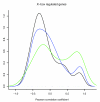Identification of ciliary and ciliopathy genes in Caenorhabditis elegans through comparative genomics
- PMID: 17187676
- PMCID: PMC1794439
- DOI: 10.1186/gb-2006-7-12-r126
Identification of ciliary and ciliopathy genes in Caenorhabditis elegans through comparative genomics
Abstract
Background: The recent availability of genome sequences of multiple related Caenorhabditis species has made it possible to identify, using comparative genomics, similarly transcribed genes in Caenorhabditis elegans and its sister species. Taking this approach, we have identified numerous novel ciliary genes in C. elegans, some of which may be orthologs of unidentified human ciliopathy genes.
Results: By screening for genes possessing canonical X-box sequences in promoters of three Caenorhabditis species, namely C. elegans, C. briggsae and C. remanei, we identified 93 genes (including known X-box regulated genes) that encode putative components of ciliated neurons in C. elegans and are subject to the same regulatory control. For many of these genes, restricted anatomical expression in ciliated cells was confirmed, and control of transcription by the ciliogenic DAF-19 RFX transcription factor was demonstrated by comparative transcriptional profiling of different tissue types and of daf-19(+) and daf-19(-) animals. Finally, we demonstrate that the dye-filling defect of dyf-5(mn400) animals, which is indicative of compromised exposure of cilia to the environment, is caused by a nonsense mutation in the serine/threonine protein kinase gene M04C9.5.
Conclusion: Our comparative genomics-based predictions may be useful for identifying genes involved in human ciliopathies, including Bardet-Biedl Syndrome (BBS), since the C. elegans orthologs of known human BBS genes contain X-box motifs and are required for normal dye filling in C. elegans ciliated neurons.
Figures




Similar articles
-
The in vivo dissection of direct RFX-target gene promoters in C. elegans reveals a novel cis-regulatory element, the C-box.Dev Biol. 2012 Aug 15;368(2):415-26. doi: 10.1016/j.ydbio.2012.05.033. Epub 2012 Jun 5. Dev Biol. 2012. PMID: 22683808
-
Functional genomics of the cilium, a sensory organelle.Curr Biol. 2005 May 24;15(10):935-41. doi: 10.1016/j.cub.2005.04.059. Curr Biol. 2005. PMID: 15916950
-
Transcriptional profiling of C. elegans DAF-19 uncovers a ciliary base-associated protein and a CDK/CCRK/LF2p-related kinase required for intraflagellar transport.Dev Biol. 2011 Sep 1;357(1):235-47. doi: 10.1016/j.ydbio.2011.06.028. Epub 2011 Jun 27. Dev Biol. 2011. PMID: 21740898 Free PMC article.
-
Comparative genomics in C. elegans, C. briggsae, and other Caenorhabditis species.Methods Mol Biol. 2006;351:13-29. doi: 10.1385/1-59745-151-7:13. Methods Mol Biol. 2006. PMID: 16988423 Review.
-
Lifting the lid on Pandora's box: the Bardet-Biedl syndrome.Curr Opin Genet Dev. 2005 Jun;15(3):315-23. doi: 10.1016/j.gde.2005.04.006. Curr Opin Genet Dev. 2005. PMID: 15917208 Review.
Cited by
-
Novel asymmetrically localizing components of human centrosomes identified by complementary proteomics methods.EMBO J. 2011 Apr 20;30(8):1520-35. doi: 10.1038/emboj.2011.63. Epub 2011 Mar 11. EMBO J. 2011. PMID: 21399614 Free PMC article.
-
A network-based approach to dissect the cilia/centrosome complex interactome.BMC Genomics. 2014 Aug 7;15(1):658. doi: 10.1186/1471-2164-15-658. BMC Genomics. 2014. PMID: 25102769 Free PMC article.
-
Functional specialization of sensory cilia by an RFX transcription factor isoform.Genetics. 2010 Dec;186(4):1295-307. doi: 10.1534/genetics.110.122879. Epub 2010 Oct 5. Genetics. 2010. PMID: 20923979 Free PMC article.
-
Regulating the transition from centriole to basal body.J Cell Biol. 2011 May 2;193(3):435-44. doi: 10.1083/jcb.201101005. J Cell Biol. 2011. PMID: 21536747 Free PMC article. Review.
-
C. elegans PPEF-type phosphatase (Retinal degeneration C ortholog) functions in diverse classes of cilia to regulate nematode behaviors.Sci Rep. 2024 Nov 16;14(1):28347. doi: 10.1038/s41598-024-79057-z. Sci Rep. 2024. PMID: 39550471 Free PMC article.
References
-
- Kozminski KG, Forscher P, Rosenbaum JL. Three flagellar motilities in Chlamydomonas unrelated to flagellar beating. Video supplement. Cell Motil Cytoskeleton. 1998;39:347–348. - PubMed
Publication types
MeSH terms
Substances
LinkOut - more resources
Full Text Sources
Molecular Biology Databases
Miscellaneous

